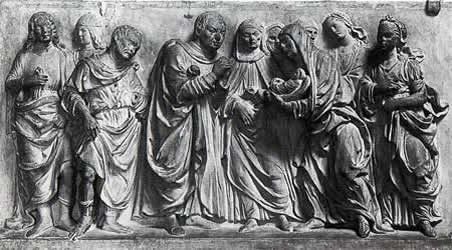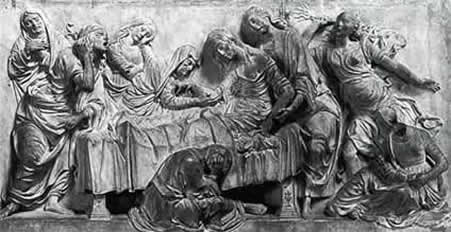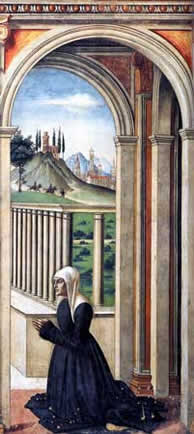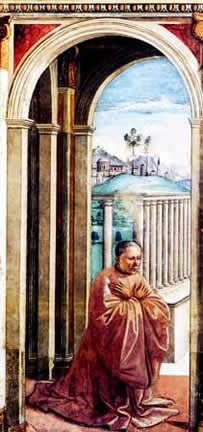Katrina Genuis
Victoria, Canada
Introduction

Marble Relief Sculpture. From the workshop of Andrea del Verrocchio.
Museo Nazionale del Bargello, Florence, Italy
The Italian Renaissance. These mere words herald a mental avalanche of associations; images of flourishing architecture, fresco paintings, overflowing libraries, and expanding commerce flow into our minds. As was the case for most historical eras, however, reality was far more complex than the artistic projections of the day suggest. Ironically, in this period of societal ‘Renaissance,’ or ‘rebirth,’ the true complexity, confusion, and peril of birth itself, a central human experience, remained obscured by idealistic representations.
Amidst vast collections of Italian Renaissance artwork depicting glorified birthing room scenes and serene new mothers, we are granted singular insight into the harsh realities of childbirth through the sculpted marble work The Death of Francesca Tornabuoni, or simply The Tornabuoni Relief (Figure 1). This relief—a type of sculpture in which figures are carved out of a flat stone background—was commissioned by Giovanni Tornabuoni for the sepulcher, or burial chamber, of his late wife Francesca Tornabuoni after her death in childbirth on September 23, 1477.1 The work was sculpted in the workshop of the famous Italian Renaissance artist Andrea del Verrocchio.2 In exploring the lives of Giovanni and Francesca, paying particular attention to the 15th century obstetrical practices which likely characterized Francesca’s experience of pregnancy and childbirth, we can better comprehend the profound significance of the sorrowful scene immortalized in this monument.
Early history of Giovanni and Francesca
Thanks to the record keeping practices of Renaissance Italian elite, we are first introduced to Giovanni and Francesca through family accounts and financial documentation. Giovanni’s sister, Lucrezia, married Piero di Cosimo de Medici in 1443; in binding her fate to that of the legendary Medici, she significantly advanced the Tornabuoni family’s social and financial prowess. Giovanni’s destiny, in particular, was dramatically altered by this connection. By 1465, Giovanni had become the director of the Medici bank in Rome. Not only did Giovanni’s influence spread throughout the Italian banking world, but as financial advisor and treasurer to Pope Sixtus IV, we can hypothesize that he impacted crucial religious decisions of the day.3 In 1466, Giovanni and Francesca married and soon after had a son, Lorenzo, and a daughter, Ludovica.
Societal approaches to pregnancy and labor
Francesca’s first two successful pregnancies and births were likely carried out and celebrated in the ritual manner of the Italian elite, a process portrayed on numerous painted bowls, decorated birth trays, and wall paintings recovered from the Renaissance period. Francesca’s bedchamber may have been adorned with painted “men of dignity and handsome appearance,”4,1 due to prevailing notions that “whatever [women] view . . . just so do they procreate the progeny.”5,1 A birthing room suiting her social class would have been warmed with a crackling fire and furnished lavishly with chests, decorated tables, a specific birthing chair, and an elaborate, cushioned bed. Sumptuous painted scenes portray post-delivery mothers; dressed in striking gowns and headdresses, they are adorned in jewelry, saintly relics, and amulets while visitors offer them food and gifts. Interestingly, this celebration of childbirth through material objects and rituals was not limited to the elite; birthing items and food were charitably donated or loaned to servants and poorer families who could not afford the proper birthing household inventory.1
As birthing artwork expanded in variety and popularity, men were progressively prompted to be of help and support to their pregnant wives. A sermon by San Bernardino, in 1427, highlights this changing marital focus: “As you see that in every way she endures toil, so you, husband . . . make sure that you help her bear her toil. When she is pregnant or in childbirth, help her in whatever you can, since that is your child.”6,1 The Renaissance also brought with it increasing awareness of the unique health needs of pregnant women. The 15th century writings by the famous Italian physician, Michele Savonarola, direct attention to a proper diet regimen for expecting mothers.7 Clearly, this historical era was a time of growing appreciation for the task of childbearing amongst rich and poor alike.
Although society increasingly recognized the significance of childbirth, the experience was not always celebratory; rather, it carried grave risk for both mother and child. In examining birth-related artwork, Italian Renaissance researcher Jacqueline Musacchio, points out that “although traditionally referred to as birth scenes, only a few of these images depict actual childbirth.”1 Musacchio hypothesizes that the overwhelmingly positive birthing imagery of the day served an essential social purpose: the constructed sense of glorified anticipation mediated the difficult and dangerous reality of labor. Evidence for the true hazards of pregnancy in 15th century Italy is available in the form of Italian death registers; childbearing was one of the leading causes of deaths in young, married women.8 In fact, prior to medical developments of the 19th century, an average of 1.3% of pregnancies resulted in the mother’s death.9
Hints of the frantic uncertainty and fear surrounding pregnancy are discernible within superstitious Renaissance practices. Expecting mothers would carry diamonds to prevent miscarriage. Family members might seek to affect the child’s gender by displaying calligraphic texts with word Maschio, or male, to the pregnant women. Once labor began, women sought pain relief and a quick labor by shaking the mineral aetite.1 Awareness of the risk of pregnancy made its way into financial structures of the day; special insurance was available for families of pregnant women and many women wrote their wills during their first pregnancy.10 The existence of these traditions and morose practices further highlights the dark underbelly of pregnancy and labor in Renaissance Italy.
Bringing the Tornabuoni Relief into focus

Figure 2: The Death of Francesca Tornabuoni; Left scene
After considering the childbirth customs and risks of Francesca Tornabuoni’s era, we are better poised to specifically examine the circumstances of her death in 1477, as starkly depicted by the Tornabuoni Relief. This 45.5 cm by 169.5 cm monument is composed of two parallel scenes.11 Observing the left hand portion of the relief we witness the presentation of a child to a stoic, authoritatively dressed gentlemen—likely Giovanni (Figure 2).
Between the elderly woman presenting the child and Giovanni stands a man in physician’s attire solemnly observing the proceedings. As uncomplicated deliveries were attended by midwives, the physician’s presence implies that medical emergency occurred. Drawing together features of Giovanni’s soberly clasped hands, the physician’s grave expression, the somber observing crowd, and the old woman’s outstretch exhibition of the swaddled babe, we perceive that the child is dead.

Figure 3: The Death of Francesca Tornabuoni; Right scene
The right half of the relief centers on a sagging, disheveled figure, undoubtedly Francesca herself (Figure 3). Francesca’s exhaustion and weakness is overt as she is held back from slumping forward by an attendant. Her pulse is palpated by a disconcerted elderly woman, presumably her midwife and perhaps the same figure who presents the baby to Giovanni in the left hand panel. Five grieving women potently respond to Francesca’s suffering: one mournfully crosses her hands over her chest, another opens her mouth in a silent howl of grief, a third pulls violently at her own hair. The final figure in this scene, a woman in wet-nurse’s apparel whose head was knocked off of the monument at some point, cradles the limp, swaddled figure of Francesca’s stillborn child. Together, these left and right narrative scenes of the relief depict a tale of unparalleled sorrow: the medically catastrophic childbirth which ended Francesca’s life and permanently altered Giovanni’s.
Exploring the mystery of Francesca’s death: complicated deliveries and medical approaches
Considering the relative lack of burial ornaments dedicated to females in the Italian Renaissance, let alone an image depicting the manner of a woman’s death, we can surmise that Francesca’s death deeply affected those around her. Undoubtedly, one of those most impacted was Giovanni. In a letter written to his nephew, Lorenzo il Magnifico, the day following Francesca’s death, Giovanni’s grief is palpable:
My most dear Lorenzo. I am so oppressed by grief and pain for the most bitter and unforeseen accident of my most sweet wife that I myself do not know where I am. As you will have heard yesterday, as pleased God, at the 22nd hour she passed from this life in childbirth, and the infant, having cut her open, we extracted from the body dead, which to me was a double grief still. I am certain that for your usual mercy you have compassion on me and excuse me if I do not write to you at length.12,1
This letter serves not only as a testament to Giovanni’s profound sorrow at Francesca’s passing, but it sheds light on mysterious circumstances of the Tornabuoni Relief’s deadly marble scene. Giovanni refers to the incident with utter shock; we can hypothesize that either that there were few warning symptoms of the difficult delivery to come or that these concerns were hidden from Giovanni. From both the poignant expressions of distress sculpted into the Tornabuoni Relief and Giovanni’s stark account of the incident, we also recognize that Francesca suffered extraordinarily. In a time when the weak anesthetic methods that did exist were frowned upon by governing church institutions, Francesca’s pain throughout the complicated labor was indubitably excruciating.13
Not only was labor itself agonizing for Francesca, but midwives and physicians at the time would have been largely unprepared to manage her obstetrical complications. Based on Giovanni’s account of Francesca’s death, it is clear that her child was unable to progress normally through the birth canal. Challenges, such as an infant delivering buttocks or legs first, rather than the normal headfirst direction, through the birth canal required expertise to manage. An infant positioned transversely in the pelvis, a catastrophically “undeliverable” position, was universally fatal without operative intervention. Edward Shorter, in his book History of Women’s Bodies, describes the four responses of historical midwives and physicians to difficult deliveries: (1) “do nothing,” (2) experiment with folkloric methods, such as having the mother drink urine, burning the mother’s armpit hair, or rubbing special concoctions on her, (3) pull “on whatever presents itself,” or (4) attempt “an obstetric operation.”9 Thus amidst complicated deliveries, the otherwise life-bringing occurrence of birth escalated into a life-threatening juncture.7
Shorter hypothesizes that the ultimate causes of historical maternal deaths were primarily infection, hemorrhage, traumatic shock, or eclamptic convulsions, now recognized as tonic-clonic seizures.7 Unfortunately, the prolongation of Francesca’s suffering and death, perhaps due to one of these causes, additionally resulted in the death of her child. Giovanni’s description of “[extracting the infant] from the body dead” after “[having cut her open],” implies that a cesarean-type procedure was performed on Francesca’s body in an unsuccessful attempt to save the trapped, oxygen-deprived child within.12,1 Although minor in the scope of the tragedy, it is perhaps important to at least note that no evidence of this operation is shown in the Tornabuoni Relief. In accordance with the style of Renaissance sculpture, it is probable that the artist sought to portray the overall narrative of tragic demise and mourning rather than depict the exact sequence and specifics of the death.
The Tornabuoni Relief and related artwork: creation, location, and timeline

Figure 4.2: Portrait of Francesca Tornabuoni in the Santa Maria Novella Basilica
Fresco, c.1486-1490
Domenico Ghirlandaio
Santa Maria Novella Basilica, Florence, Italy

Figure 4.1: Portrait of Giovanni Tornabuoni in the Santa Maria Novella Basilica
Fresco, c.1486-1490
Domenico Ghirlandaio
Santa Maria Novella Basilica, Florence, Italy
The details of the creation of the Tornabuoni Relief still remain somewhat obscure. Its authorship, though largely attributed to Andrea del Verrocchio or one of his pupils, is notably contested in due to the uncharacteristic crudeness of “ill proportioned” figures and “coarsely fashioned feet.”12 Nevertheless, alternative authorship hypotheses have not been substantiated; the piece is generally included—often with footnotes highlighting its ambiguous authorship—in volumes of Verrocchio’s work. The sculpture itself was finished in 1478/79 and placed as a “pedestal-type base for the sarcophagus on which lay the figure of the deceased,” within the Basilica Santa Maria sopra Minerva, Rome.14
Eight years following Francesca’s death, Giovanni, who had moved to Florence, commissioned renowned Renaissance artist Domenico Ghirlandaio to create a fresco within the Santa Maria Novella Basilica. Through this work, we are granted one final touching glimpse of the Tornabuoni family.15 Husband and wife are painted across from one another in devout poses of prayer. (Figures 4.1 and 4.2) Clearly Francesca’s memory was long cherished by her husband although her lifetime was cut tragically short.
After Giovanni’s line ended in 1588, Francesca’s sarcophagus was moved elsewhere and has since been lost. The Tornabuoni Relief, however, was fortuitously separated from the sarcophagus and transferred to Florence where it is currently displayed in the Museo Nazionale del Bargello.
Concluding reflections
The Italian Renaissance was indeed a period of societal rebirth; renewed appreciation of art, history, and literature profoundly impacted the cultural climate of the day. Aspects of life not previously celebrated to such a degree—specifically pregnancy and childbirth—were glorified in decorative artwork, cherished household items, and ritualized traditions. This glorification created a superficial aura of peace and assurance surrounding pregnancy and childbirth which combated the undercurrent of trepidation that pervaded women’s childbearing years. As one of the most crucial intersections between medicine and everyday life, childbirth was a pivotal and vulnerable experience. In light of the prevalence of death during childbirth, the rarity of the Tornabuoni Relief is remarkable and renders it an artistic cornerstone of its era, truly sparking new insight and empathy in the mind of the observer. Through the Tornabuoni Relief we experience Francesca Tornabuoni’s horrendous death and Giovanni Tornabuoni’s unparalleled agony; history remains silent about the thousands of others who suffered similar fates.
References
*When two reference numbers are used together, the first is the original source and the second is the source the author used.
- Musacchio JM. The Art and Ritual of Childbirth in Renaissance Italy. New Haven: Yale University Press; 1999.
- Covi DA. Andrea Del Verrocchio: Life and Work. Firenze: Leo S. Olschki; 2005.
- Tinagli P. Women in Italian Renaissance Art: Gender, Representation, Identity. New York: St. Martin’s Press; 1997:64-65.
- Alberti LB. De re aedificatoria. Italy: 1452.
- White TH, ed. The bestiary: A book of beasts, being a translation from a Latin bestiary of the twelfth century. New York: G.P Putnam’s Sons; 1960:89-90.
- Bernardine. Le prediche volgari di San Bernardino da Siena dette nella Piazza del Campo l’anno MCCCCXXVII, ora primamente edite da Luciano Banchi. Siena; 1884:116-17.
- Weiss-Amer M. Medieval Women’s Guides to Food During Pregnancy: Origins, Texts,
and Traditions. Canada Bulletin of Medical History.1993;10:5-23. http://www.cbmh.ca/index.php/cbmh/article/viewFile/292/291 (Accessed February 14, 2013) - Herlihy D, Klapisch-Zuber C. Tuscans and their families: A study of Florentine catasta of 1427. New Haven: Yale University Press; 1985:277.
- Shorter E. A History of Women’s Bodies. New York: Basic Books; 1982.
- Chojnack S. Dowries and Kinsmen in Early Renaissance Venice. J Interdiscip Hist. 1975;5(4):571-600.
- Butterfield A. The Sculptures of Andrea Del Verrocchio. London: Yale University Press; 1959.
- Mediceo il avanti Principato, XXXV, 746.
- Serrano-del-Rosal R, Biedma-Velázquez L, García-de-Diego JM. Epidural Analgesia in Labour from a Sociological Perspective – A Case Analysis of Andalusia, Spain. In: Fyneface-Ogan, S. ed. Epidural Analgesia – Current Views and Approaches. New York: InTech; 2012. http://www.itechopen.com/books/epidural-analgesia-current-views-and-approaches/epidural-analgesia-in-labour-from-a-sociological-perspective-a-case-analysis-of-andalusia-spain. (Accessed February 14, 2013)
- Passavant G. Verrocchio: Sculptures, Paintings and Drawings. London: Phaidon; 1969.
- Von Teuffel CG. Clerics and Contracts: Fra Angelico, Neroccio, Ghirlandaio and Others: Legal Procedures and the Renaissance High Altarpiece in Central Italy. Zeitschrift für Kunstgeschichte. 1999;62 (2):190-208. http://www.jstor.org/stable/1482980 (Accessed February 16, 2013)
KATRINA GENUIS is a medical student attending the University of British Columbia, Island Medical Program in Victoria, British Columbia. Prior to entering medical school, she studied a broad spectrum of subjects, including history, English literature, art history, and chemistry. She avidly seeks to incorporate explorations of literature, history, and art in her study of medicine and particularly enjoys being part of the “Arts-in-Medicine” student initiatives, such as helping create and edit the UBC Medical Humanities Newsletter.
Highlighted in Frontispiece Spring 2017 – Volume 8, Special Issue, and Fall 2013 – Volume 5, Issue 4

Leave a Reply